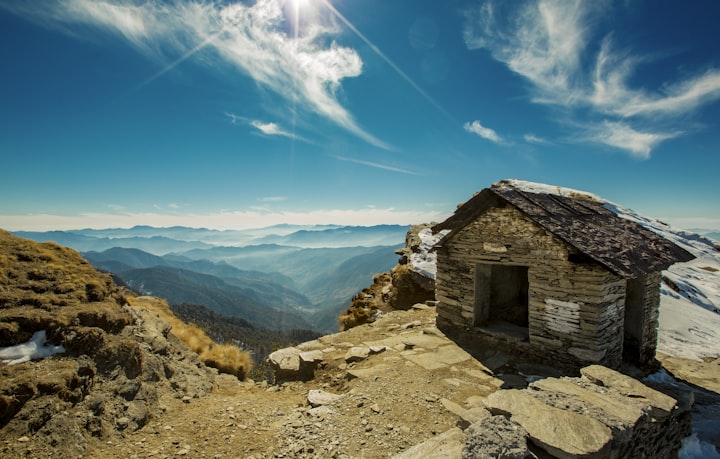How Can We Save The Mother Ganges
A river in crisis in India

From ancient times to today, Ma Ganga has nurtured and supported settlements in the massive Indus River valley.
Her source is high in the Himalayan Mountains and she flows 2,525 kilometers before emptying into the Bay of Bengal. She's also called the River Ganges.
Ma Ganga is the third largest river in the world based on discharge.
Ma Ganges is revered as a goddess.
Hindus believe she came down from heaven to cleanse the earth. Some say bathing in her waters can wash away a person’s sins. She can also aid the dead on their path toward heaven.
Increased river pollution is a real concern despite recent efforts to clean it up.
The river is considered by some to be capable of purifying itself, so the concept of a polluted Ma Ganga is blasphemous.
There are many sources of pollution. The river acts as a sewer carrying the waste of 450 million people who live in the river basin.
The Tanneries
Rakesh Jaiswal is a veteran environmental campaigner living in Kanpur. He speaks with Justin Rowlatt from the BBC about the problems he faces in his efforts to enforce environmental regulations.
Kanpur is the center of India’s large tanning industry and it’s considered the dirtiest city in the country. Together they go into the heart of the industrial area and encounter a black stream carrying industrial waste. The fumes fill the air with such strong toxins that Rowlatt has difficulty speaking. The stream includes sewage and domestic waste mixed with industrial waste from the tanning industry, which includes chromium, which is a dangerous chemical.
Recent requirements to install effluent treatment and chromium recovery systems have been imposed and the government has improved enforcement, closing down some of the worst offenders. Jaiswal indicates corruption is still preventing full enforcement of the new rules.
The two men persuade the pollution control officers to allow them to attend spot checks of tanneries in the area. They tour a clean tannery which is complying with the new rules.
When they choose the next tannery randomly, they discover a truly disgusting situation. Employees race to the back of the plant to shut down production as the officers arrive.
Investigating further, they find piles of hides lying in mounds of rotten meat and water laced with chromium. The employees tell them it has been there for at least four days in 86F heat. The officers tell the two men they are going to recommend the tannery for closure. Later, Rowlatt is puzzled when he sees the tannery is still operating.
He wonders if it will be closed or if corrupt officials have already intervened.
Farming
Water from the Ganges is used for irrigation and drinking water. There is no restriction on the amount of water taken from the many wells and canals that support the farmers who work these fertile lands and grow food for the nation.
There are more than two hundred million farmers with wells in this river basin, so the amount of water they use is substantial. Concerns have been raised about the rapidly dropping water table, which will eventually deplete the flow of the Ganges.
Rajesh Bajpai works hard to reduce the quantity of water the farmers take from their wells. Improved irrigation systems and different methods are being adopted, which is a positive step in the right direction.
The government hesitates to implement rationing or charge for water, as farmers have political power as a constituency.
Cremation and remains
Varanasi is the holiest city in India. The vast number of people using the Ganges for purification rituals here is daunting for environmentalists to control. The popular practice of riverside cremations adds to the problem.
Hindus believe if you are burned on a pyre beside the Ganges you will achieve moksha or liberation from the cycle of death and rebirth.
As many as 32,000 people are cremated here each year.
That’s an estimated 300 tons of half-burnt human remains sent into the river.
Human waste
A series of effluent treatment plants have been built over the years but most are not working at capacity. An additional problem is; only a third of the homes in Varanasi are connected to the sewer system and the rest dump directly into the river. Similar situations exist in other cities along the river.
When a relative cannot afford cremation, the body is weighed down with stones and pushed into the river. The Centre for Science and the Environment reports that 80% of the human waste that goes into the river is untreated.
A Plan to Save the Ganges
A series of commercials intended to encourage people to stop littering featured the Goddess Lakshmi. When someone littered, they discovered the image of their Goddess had disappeared from their personal shrine. The hashtag #DontLetHerGo is featured.
Prakesh Javadekar, the Indian Environment Minister, oversees a “Clean the Ganges” plan set out by the Prime Minister. There is a budget to clean up the river although it is estimated to take 10–15 years. It is frustrating to hear it will take so long, but the cleanup efforts have just begun and it will be a slow process.
Other countries have polluted their rivers so badly that they were declared biologically dead.
The Thames River in London, England was so polluted when a steamship sunk in 1878, more than 600 passengers were overcome by the toxins in the river and died.
In the late 1960s improvements to sewage systems and stricter environmental regulations started to turn it around. Now the river has been transformed. It won an international prize in 2010 for its restoration.
The Prime Minister, Narendra Modi, has declared that cleaning the Ganges is his sacred mission. He has pledged over 2 billion pounds over 5 years to the cleanup effort and has made this project one of his most important goals during his time in office.
It will take years, but India has the chance to prove it can tackle this restoration with success.
Sources:
Justin Rowlatt, India’s Dying Mother, BBC News, May 12, 2016.
Antonia Blumberg, “With The Help Of Beloved Goddess, India’s Massive Sanitation Problems Could Take A Turn,” Huffington Post, August 12, 2016.
If you enjoyed this story, send me a tip so I can write another one.
Or share it on social media. Your recognition means a lot to me.
A version of this story also appears on Medium by Tree Langdon, the author.
About the Creator
Tree Langdon
Get an idea, a new word and a question.
For more, read my bio here.






Comments
There are no comments for this story
Be the first to respond and start the conversation.